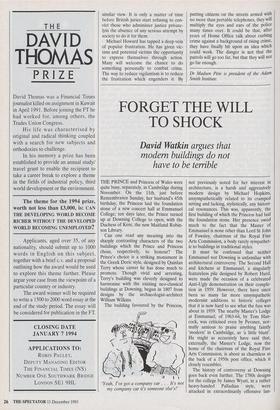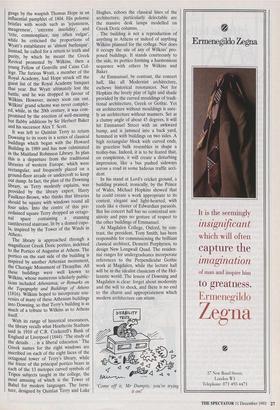FORGET THE WILL TO SHOCK
David Watkin argues that
modem buildings do not have to be terrible
THE PRINCE and Princess of Wales were quite busy, separately, in Cambridge during November. On the 11th, just before Remembrance Sunday, her husband's 45th birthday, the Princess laid the foundation stone of a new concert hall at Emmanuel College; ten days later, the Prince turned up at Downing College to open, with the Duchess of Kent, the new Maitland Robin- son Library.
Can one read any meaning into the sharply contrasting characters of the two buildings which the Prince and Princess chose, respectively, to honour? The Prince's choice is a striking monument in the Greek Doric style, designed by Quinlan Terry whose career he has done much to promote. Though vivid and arresting, Terry's building was cleverly designed to harmonise with the existing neo-classical buildings at Downing, begun in 1807 from designs by the archaeologist-architect William Wilkins.
The building favoured by the Princess, `Yeah, I've got a company car . . . It's not my company car it's someone else's!' not previously noted for her interest in architecture, is a harsh and aggressively modern design by Michael Hopkins, unsympathetically related to its cramped setting and lacking, stylistically, any histori- cal resonances. This was, apparently, the first building of which the Princess had laid the foundation stone. Her presence owed much to the fact that the Master of Emmanuel is none other than Lord St John of Fawsley, chairman of the Royal Fine Arts Commission, a body rarely sympathet- ic to buildings in traditional styles.
It must be confessed that neither Emmanuel nor Downing is unfamiliar with architectural controversy. The Second Hall and kitchens at Emmanuel, a singularly featureless pile designed by Robert Hurd, were made the occasion of a celebrated Anti-Ugly demonstration on their comple- tion in 1959. However, there have since been so many far more unsympathetic modernist additions to historic colleges that it is now hard to see what the fuss was about in 1959. The nearby Master's Lodge at Emmanuel, of 1963-64, by Tom Han- cock, was criticised even by Pevsner, nor- mally anxious to praise anything faintly `modern' in Cambridge, as 'a little blunt'. He might as accurately have said that, externally, the Master's Lodge, now the home of the chairman of the Royal Fine Arts Commission, is about as charmless as the back of a 1950s post office, which it closely resembles.
The history of controversy at Downing goes back even further. The 1780s designs for the college by James Wyatt, in a rather heavy-handed Palladian style, were attacked in extraordinarily offensive Ian- guage by the waspish Thomas Hope in an Influential pamphlet of 1804. His polemic bristles with words such as 'jejuneness, meagreness', 'extreme insolidity', and trite, commonplace, nay often vulgar', while he criticised the proportions of Wyatt's entablature as 'almost burlesque'.
Instead, he called for a return to truth and purity, by which he meant the Greek Revival promoted by Wilkins, then a young Fellow of Gonville and Caius Col- lege. The furious Wyatt, a member of the Royal Academy, had Hope struck off the guest list of the Royal Academy banquet that year. But Wyatt ultimately lost the battle, and he was dropped in favour of Wilkins. However, money soon ran out. Wilkins' grand scheme was never complet- ed, while, in the 20th century, it was com- promised by the erection of well-meaning but flabby additions by Sir Herbert Baker and his successor Alex T. Scott.
It was left to Quinlan Terry to return Downing to its roots in a series of classical buildings which began with the Howard Building in 1989 and has now culminated in the Maitland Robinson Library. In plan this is a departure from the traditional libraries of western Europe, which were rectangular, and frequently placed on a ground-floor arcade or undercroft to keep out damp. In fact, the plan of the Downing library, as Terry modestly explains, was provided by the library expert, Harry Faulkner-Brown, who thinks that libraries should be square with windows round all four sides. Into the centre of this pre- ordained square Terry dropped an octago- nal space containing a stunning cantilevered staircase, lit by a domed cupo- la, inspired by the Tower of the Winds in Atheni.
The library is approached through a magnificent Greek Doric portico, indebted to the Portico of Augustus at Athens. The portico on the east side of the building is inspired by another Athenian monument, the Choragic Monument of Thrasyllus. All these buildings were well known to Wilkins, whose numerous scholarly public- bons included Atheniensa, or Remarks on the Topography and Buildings of Athens (1816). Wilkins hoped to incorporate sou- venirs of many of these Athenian buildings into Downing, so that Terry's building is as much of a tribute to Wilkins as to Athens itself.
With its range of historical resonances, the library recalls what Heathcote Statham said in 1910 of C.R. Cockerell's Bank of England at Liverpool (1844): 'The study of the details . . . is a liberal education.' The Greek names for the eight windows are inscribed on each of the eight faces of the octagonal tower of Terry's library, while the frieze of the principal portico bears in each of the 13 metopes carved symbols of Tripos subjects taught in the college, the most amusing of which is the Tower of Babel for modern languages. The furni- ture, designed by Quinlan Terry and Luke Hughes, echoes the classical lines of the architecture; particularly delectable are the massive desk lamps modelled on Greek Doric columns.
The building is not a reproduction of anything in Athens or indeed of anything Wilkins planned for the college. Nor does it occupy the site of any of Wilkins' pro- posed buildings. It stands courteously to the side, its portico forming a harmonious sequence with others by Wilkins and Baker.
At Emmanuel, by contrast, the concert hall, like all Modernist architecture, eschews historical resonances. Not for Hopkins the lovely play of light and shade provided by the curved mouldings of tradi- tional architecture, Greek or Gothic. Yet an architecture without mouldings is sure- ly an architecture without manners. Set at a clumsy angle of about 45 degrees, it will hit Emmanuel Street with an awkward bump, and is jammed into a back yard, hemmed in with buildings on two sides. A high rectangular block with curved ends, its graceless bulk resembles in shape a trolley-bus. Indeed, it is to be feared that, on completion, it will create a disturbing impression, like a bus pushed sideways across a road in some hideous traffic acci- dent.
In his stand at Lord's cricket ground, a building praised, ironically, by the Prince of Wales, Michael Hopkins showed that he could create a work appropriate to its context, elegant and light-hearted, with roofs like a cluster of Edwardian parasols. But his concert hall has no contextual sen- sitivity and pays no gesture of respect to the other buildings of Emmanuel.
At Magdalen College, Oxford, by con- trast, the president, Tony Smith, has been responsible for commissioning the brilliant classical architect, Demetri Porphyrios, to design New Longwall Quad. The residen- tial ranges for undergraduates incorporate references to the Perpendicular Gothic work at Magdalen, while the lecture hall will be in the idealist classicism of the Hel- lenistic world. The lesson of Downing and Magdalen is clear: forget about modernity and the will to shock, and there is no end to the charm and appropriateness which modern architecture can attain.
`Come off it, Mr Dumpty, you're trying it on!'



































































 Previous page
Previous page